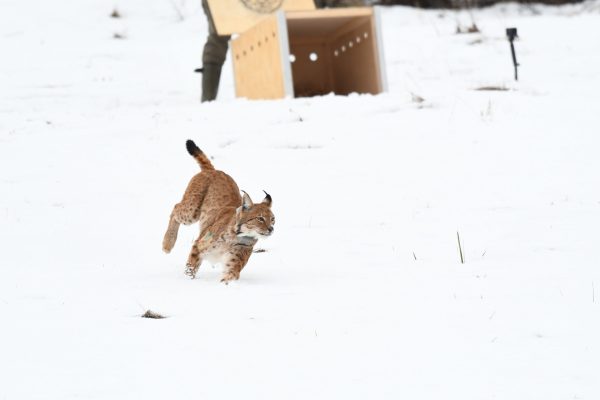After two-and-a-half month recovery at The Bor Zoo, due to being injured on the Djerdap highway, the lynx species is returned to its natural habitat, Djerdap National Park.
With the permit of the Ministry of Environmental Protection in partnership with Faculty of Biology University of Belgrade the male lynx species has been marked and chipped with a GPS collar which will help track its movement in great detail within the borders of his natural habitat. Attendees who helped with the lynx’s return, who in the meantime got the name ‘‘Rista’’ were Sara Pavkov, The Secretary of State, along with representatives of Ministry of Environmental Protection, Dusko Cirovic (PhD), Professor at the Faculty of Biology University of Belgrade, representatives of Enviroment Protection Institute of Serbia, The Bor Zoo, and lastly Djerdap National Park.

The day when the recovered lynx was returned to its natural habitat is regarded as a day to remember. Ministry of Environmental Protection, Djerdap National Park, along with The Secretary of State Sara Pavkov, thanked everyone that took part in recovery and taking care of the lynx species who has been injured on the Djerdap highway in mid November of the last year.
This, along with some other species of plants and animals that make the Djerdap National Park so distinguishable are of the utmost importance when it comes to their preservation. This particular lynx species alone represents 2% of the lynx population that resides on the territory of Serbia. Sara Pavkov, The Secretary of State highlighted the importance of the lynx being returned by saying “No matter the fact that to someone it might seem hardly meaningful that a single lynx species has been returned to its natural habitat, trust me when I say it truly is”.
Photo author: Ministry of Environmental Protection
On this occasion she emphasized that the Ministry of Environmental Protection has been increasing its funds every year since 2020. to subsidize protected areas. Taking as an example Djerdap National Park, she cited that for this particular protected area it had been invested 14 milion Serbian dinars in the year 2020. and in 2022. over 17 milion.
We envision an immense increase of funds for the year 2023. said Sara Pavkov, and thanked the Acting Director of Djerdap National Park Sasa Janosevic, who, as she pointed out “invests great effort in order for this protected area to represent pride, not only in Serbia, but in wider areas as well, so that we could feel joy and have more than enough knowledge and expertise.
Sasa Janosevic, Acting Director of Djerdap National Park vocalizes that the day when the lynx was taken back to its natural habitat after a successful recovery, was a very special day for Djerdap National Park as well as for the Ministry of Environmental Protection.
It is exceedingly crucial to point out the fact that The Government of the Republic of Serbia is constantly increasing its investment funds when it comes to protected areas, and the evidence is in collected data that says that in 2020. the budget of Serbia invested in the Ministry of Environmental Protection 2,7 billion Serbian dinars, whereas today, in 2023. the numbers show 18 billion which is an increase by more than 260% – highlighted Janosevic, thanking the Ministry of Environmental Protection, Faculty of Biology University of Belgrade, together with Professor Cirovic, and finally The Bor Zoo who looked after the injured lynx the most.
According to Professor at the Faculty of Biology University of Belgrade, Dusko Cirovic (PhD), a truly valuable lynx species has been rescued and taken back to its natural habitat.
-This is an adult male, it is also the month of February, and we are all aware what cats do in February, so we truly hope that he will be able to find a mate and leave us with an offspring. We did not only return him but also allowed this endangered species of large mammals to fully recover. We don’t have a high number of lynxes, our expert estimate shows that there are around 40-60 species, and the fact that we succeeded in helping this species heal, and bring it back to its natural habitat is of the utmost importance. – says Dusko Cirovic (PhD).
He drew attention to the fact that this is the very first lynx marked by a GPS collar, along with a reminder that in 2001. there was also a lynx marked by a radio transmitter in Djerdap National Park.
We hope that lynx Rista will send us information about his whereabouts throughout the next year. We will be on top of things and in case something goes awry, we will be able to intervene. We expect that he will send us somewhere around 2,5 thousands of data of his movement, and we will use that data to not only protect him but also use it for the future conservation measures with the goal to recover the population of lynxes in Serbia – Cirovic considers.
A true freckled beaty, as Vladan Bjedov from Enviroment Protection Institute of Serbia says, he began living a new life, but he will also offer us data of immeasurable value which will contribute to further protection of species and habitats.
It is truly wonderful to give something back to nature as well as into nature, but it is also just as important to have a place to give back to. That is why valuable areas such as Djerdap National Park are of high priority when it comes to habitat conservation, and the entire wider area that surrounds it, it represents exceptionally suitable habitat not only for the lynx but also for the whole sequence of truly captivating species. Our mission is to preserve their conservation status and certainly advance in the period ahead of us. – Vladan Bjedov evaluates.




















